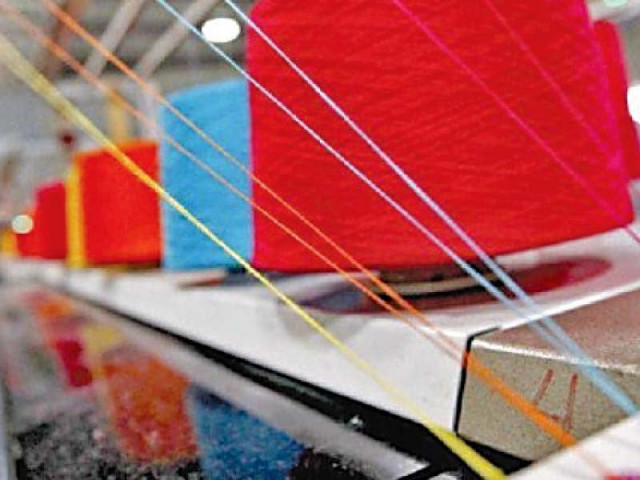Textile sector struggles over gas issues
Ministries clash over solutions as transition to power grid poses challenges

The textile industry is in hot waters due to the government's decision to cut off gas supply to captive power plants and push them to connect to the power grid. Sources revealed to The Express Tribune that ministers for power and petroleum have not been on the same page in resolving this issue.
In a recent meeting of the Economic Coordination Committee (ECC), the Petroleum Division reported that the government has been gradually discouraging the use of natural gas for captive power generation. The division suggested revising the gas supply priority order to minimise gas consumption by captive power plants.
The Minister of State for Finance and Revenue agreed with this suggestion, proposing that gas tariffs for captive power be raised to match the higher RLNG (Re-gasified Liquefied Natural Gas) tariffs, thereby disincentivising their operation. The power minister, however, insisted that connectivity to the national power grid must be ensured for these units before cutting off gas supply. He also endorsed the proposal to raise gas tariffs for captive power plants.
The petroleum minister argued that the Power Division should have estimated the timelines for connecting captive power plants to the grid, warning that the gas disconnectiona structural benchmark of the International Monetary Fund (IMF)could have negative consequences for the industry and the wider economy.
Despite these concerns, it was explained that the issue had been discussed back in 2021, but no action was taken. The meeting concluded that gas prices should be used as a tool to push industries toward grid-based power. The ECC agreed to notify captive power producers about the impending gas disconnection by the start of 2025.
To further discuss the matter, the ECC recommended that the petroleum, power, and finance divisions meet to devise a way forward. The committee approved the revised priority list for gas supply, which places captive power plants, along with cement and CNG sectors, last.
Historical context and
policy shifts
The Petroleum Division informed the ECC that the government has been encouraging industries to move away from gas for captive power generation for several years. The 2005 Natural Gas Allocation and Management Policy laid out a merit-based order for gas supply, which has undergone several revisions since then. In 2013, the government allowed gas utility companies to manage gas load according to this policy.
In 2018, the textile industry, categorised as an export sector, was provided a subsidy for RLNG at $6.5 per MMBTU, which was later raised to $9 per MMBTU in fiscal year 2023. However, this subsidy ended on July 1, 2023, leaving industries reliant on indigenous and RLNG resources as per the ECC's November 2023 decision. In February 2024, the distinction between export and non-export sectors was eliminated, and industries were classified based on process or captive power generation.
Captive power units and industrial challenges
The textile industry, like many others, has invested heavily in captive power generation to ensure uninterrupted production, particularly during periods of power grid instability and rising electricity tariffs. Captive power plants not only generate electricity but also produce steam, a crucial element in industrial processes.
However, with the government's focus on optimising national energy use and phasing out gas-based captive power, the industry is facing an uphill battle. In the past, the government allowed some captive power units to sell surplus electricity to the national grid, but very few companies were able to obtain the necessary approvals.
Attempts to audit the efficiency of captive power units were proposed as far back as 2011 but never materialised. Several industries filed legal challenges, obtaining restraining orders that halted the disconnection of their gas supplies.
As part of Pakistan's commitments to the IMF, the government plans to phase out gas supply to captive power plants by January 2025. In preparation, gas tariffs for these units were raised from Rs2,750 per MMBTU to Rs3,000 per MMBTU, effective July 1, 2024. Meanwhile, the Power Division has conducted surveys and load assessments of captive power units to prepare them for grid connectivity.
Industry response and economic implications
The decision to place captive power units at the bottom of the gas supply priority list has raised concerns in the textile sector, which accounts for 60% of Pakistan's exports. The industry is already reeling from high production costs, energy shortages, and global market competition. Textile exporters have warned that production costs could rise by 30%, while exports may drop by 20%. To make matters worse, the government has yet to pay Rs100 billion in refunds owed to the sector.
Industry stakeholders have appealed to the Special Investment Facilitation Council (SIFC) to intervene and address their concerns. They argue that balancing the energy needs of various sectors is critical for ensuring the survival and competitiveness of the textile industry.
In their appeal, textile producers have requested energy subsidies, including gas at $6-7 per MMBTU and electricity at Rs5-6 per unit. They have also called for financial relief through the payment of pending refunds, a reduction in customs duties, and sales tax exemptions on raw materials.



















COMMENTS
Comments are moderated and generally will be posted if they are on-topic and not abusive.
For more information, please see our Comments FAQ